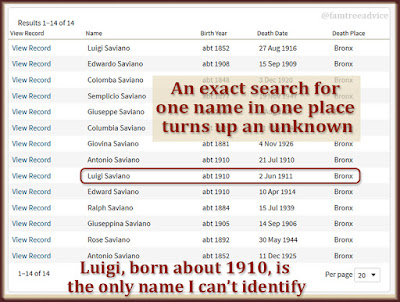Break out of your genealogy rut by choosing a new-to-you research path.
Do you ever get a little bored by your genealogy research? Are you so deep into one branch that you're ignoring the rest of your family tree?
Pick a new branch to liven things up. Here are 3 ways to find a new dead end to explore:
- Look for the blanks in your grandparent or ahnentafel chart.
- Color-code your direct ancestors (in Family Tree Maker) to see where each line ends.
- Create ancestor charts that include blanks for the missing generations. Those blanks will help you spot the holes.
Now pick a branch you haven't spent much time on. That'll freshen things up.
I've decided to research a branch from an Italian town I haven't explored—Apice. I learned from my 3rd great grandmother's death record that she was born there.
My 3rd great grandmother was Rufina Zullo. Her daughter, my 2nd great grandmother, came to America the year Rufina died—1898. That's a little sad and makes me want to go further on Rufina's branch of my family tree.
Here's what I'll do.
1. Gather Research Documents
I'll download the Apice vital records to my computer. If you're lucky enough to have your ancestral towns' records online, download them all. Find out how to use the Antenati Italian archives and download the records. Check that page's comments for a program that can download from Family Search.
 |
| Figure out what you know and when and where you should look. |
2. Label the Related Images
I'll mark the image files that have last names from this branch. The last names of Rufina Zullo's great grandparents were Zullo, Trancuccio, Montenigro, and Lomaglio. I learned these names from the death records of Rufina's parents.
When I find a death record with 1 of those 4 names, I'll rename the image file name to include the deceased's name.
 |
| You'll never wonder where you saw that one file if you rename it and make it searchable. |
By renaming the images, I'm creating a searchable database of Apice vital records on my computer. Of course, as I'm renaming the files, I'll keep an eye out for the 4 exact people I want to find:
- Saverio Zullo
- Angela Montenigro
- Biase Trancuccio
- Angela Lomaglio
It's important to have that list of 4 names in front of me the whole time. I need to pounce whenever I see those names.
And may I say, Oof! This town's records are hard to read. I'm searching for the shape of those 4 names and ruling out names that can't possibly be them.
Many of the vital records for Apice don't have an index. That's why it's so important to download the whole collection. It's infinitely faster to click through the files on your computer than online.
3. Focus on the Right Timeframe
I'll target my searches to the logical years when these 4 ancestors may have died. All I know so far is that 2 died before their son did on 28 Dec 1844, and 2 died before their daughter did on 22 Aug 1837. I know this because their parents were dead when my 4th great grandparents died.
4. Examine the Results
Now comes the tricky part. I found an 1816 death record for a Saverio Zullo. That's the name of my 5th great grandfather. How can I tell if this is "my" Saverio Zullo? Let's look at the facts:
- The son of my Saverio Zullo was born in 1789. I'm using an estimated birth year for Saverio of 25 years before 1789, or 1764. I don't know when he was really born.
- The Saverio Zullo who died in 1816 was 80 years old. So he was born in 1736. It's completely possible that he could have had a child in 1789 when he was 53 years old. That is, as long as his wife was a few years younger than him.
- The 1816 death record does not say if 80-year-old Saverio was married or widowed. It only mentions his parents' names: Giuseppe and…geez…I think Libera Carese but I can't be sure yet.
I'll rename this image file and keep searching.
A few documents later I find an Angela Montenigro. This is the name of my Saverio Zullo's wife. If it is her, she is a good age to have had a child in 1789. This entire town doesn't include the name of the deceased's spouse on the death record! So I'll rename this image, too. If I search every year and never find another Saverio Zullo or Angela Montenigro, then these are probably my 5th great grandparents. I may not be 100% sure, but I can be reasonably sure.
It's also important that I keep viewing this town's records to get familiar with the names there. Angela Montenigro's mother seems to be Berardina Lavorano. If I see "Lavorano" a few more times, written clearly, I'll know that's the correct name.
In the end, I'll have marked the documents for siblings, cousins, aunts and uncles of my 3rd great grandmother. That's what I like to do—piece together extended families. That is my never-ending, never boring jigsaw puzzle.
Genealogy research is never done. That's why so many of us have been at it for years. If you find yourself in a rut, look for that unexplored branch. Can you take it back another generation or two? Think how much that can juice-up your family tree research!



